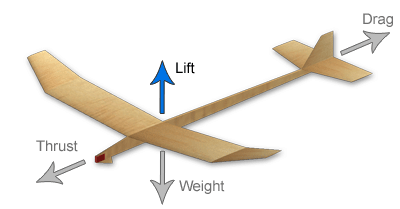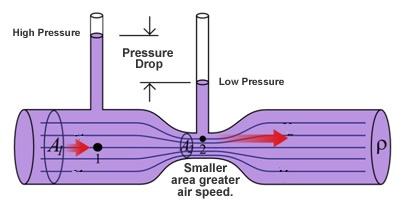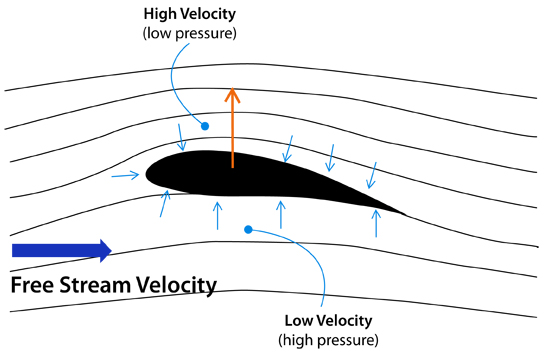Lift
Lift is the force that opposes weight and holds a glider in the air. Lift is a mechanical force - meaning that it is the result of two objects making physical contact. For a glider, the two "objects" are air (a fluid) and the surface of the wing. To understand lift, we need to understand what happens to air as it moves around the surface of the wing. Bernoulli's Principle, which was actually developed over a century before the first man-made wings were used for the purpose of flight, will help explain lift.
Bernoulli's Principle and Airfoils
Daniel Bernoulli was a mathematician who developed and published (in 1738) a principle that explains that the movement of a fluid, such as air, can cause a drop in pressure. A fluid is a substance that has no fixed shape and can change shape easily with external pressures; therefore, fluids include liquids and gasses such as air and water. Bernoulli's Principle states that as a fluid moves at a higher speed, the surrounding pressure drops. Bernoulli's Principle can be observed by using a venturi meter, which is an instrument that demonstrates how a fluid moving at a high velocity causes pressure to drop. It is also called a venturi tube.

Lift Force

A Venturi Tube
So what does this have to do with lift? Let's take a look at a cross section of a typical wing to find out. The image below is called an airfoil. An airfoil is a teardrop shape designed specifically to redirect the flow of air around the wing. Air collides with the airfoil at the leading edge and splits. For the airfoil shown below, the curvature of the upper surface will cause air to move around the upper surface at a higher velocity than the air flowing below the airfoil. Bernoulli's principle tells us that this difference in velocity results in differences in pressure, and provides a partial description of what causes lift.

Parts of an Airfoil
Mechanical forces exist when two objects come into contact, but the fact that one of our objects in this case is a fluid (air) makes the situation a bit more complicated. The "shape" of air can change as it collides with the airfoil. This means that the air literally exerts a different force on each section of the wing. The direction of the force at any location is always normal (or perpendicular) to the surface of the airfoil (as illustrated by the blue arrows in the image below). The magnitude of this force is proportional to pressure.

Airfoil Pressure
Higher pressure under the wing yields higher forces. Likewise lower pressure above the wing yields lower forces. If we added all these forces together we would find that our airfoil shape produces a total, or resultant force, pointing upwards. This is lift and it acts through the center of pressure for the wing. The center of pressure of a wing is the point where all the combined forces across the wing area result in upward force.
Lift Efficiency
Lift is a positive force, so improving lift should result in longer flight times. Lift depends on a number of factors including air density, velocity, the shape of the airfoil, and the planar area of the wing. You cannot directly control air density or velocity and the thickness of your balsa glider wing is quite thin, so the airfoil is a lot like a flat plate. So the planar area of the wing is really the only design element that you can control.
The planar area of the wing is the area of the wing if viewed from above. Note that this differs from the true surface area of a wing. The true surface area would account for both sides of the wing (upper and lower surfaces) and would also account for any dihedral.

Planar Wing Area
Theoretically, if you increase the planar area of the wing you will improve lift. But increasing the size of the wing will also increase the weight of your glider. Since lift and weight oppose one another, this creates a classic engineering trade-off. You can use a ratio called the Lift Efficiency Ratio to analyze the performance of your wing design.
As you can see by the equation, if you increase WA and/or decrease GW, then LER increases - indicating that your design change should improve the efficiency of the wing and increase flight time. As with any ratio, the opposite is also true - increasing GW and/or decreasing WA, will decrease LER and decrease the efficiency of the wing.
The LER value can be used to compare the Lift Efficiency Ratio of various glider designs. The glider with the higher LER, even if the overall weight of that glider is slightly heavier than a glider with a lower LER, should fly longer.